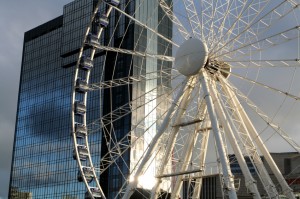 For over two hundred years, Birmingham has played a crucial role in the development of the British economy. Since the early stages of the Industrial Revolution, this West Midlands city has been undergoing constant geographic and demographic expansion. While this has put pressure on the city’s resources, it has also provided numerous opportunities for growth and development. In this article we take a look at how the various regeneration projects that will soon be a reality in Birmingham can help boost even further the local economy and transform the Midlands city into a model for successful urban planning and high standards of living.
For over two hundred years, Birmingham has played a crucial role in the development of the British economy. Since the early stages of the Industrial Revolution, this West Midlands city has been undergoing constant geographic and demographic expansion. While this has put pressure on the city’s resources, it has also provided numerous opportunities for growth and development. In this article we take a look at how the various regeneration projects that will soon be a reality in Birmingham can help boost even further the local economy and transform the Midlands city into a model for successful urban planning and high standards of living.
Birmingham’s Big City Plan
The Big City Plan is one of the most important regeneration initiatives currently underway in Birmingham. This regeneration masterplan is designed to transform the city centre area over a period of 20 years, increasing the city core’s total area by nearly 25 per cent and improving connectivity and standards of living.
The Big City Plan was devised by Birmingham City Council following the comprehensive report published by Baron Mike Whitby, who has shown a lifelong commitment to improving the city’s livability and infrastructure standards. The Big City Plan was launched in early 2008 and it is expected that once it is fully completed, it will add 1.5 million square metres of prime floorspace, create more than 50,000 jobs, build 5,000 new homes, and contribute more than £2 billion to the local economy every year.
This clearly ambitious urban regeneration plan has identified six economic zones that will attract high-value businesses to the city, which include the Jewellery Quarter, St George & St Chad, Eastside, Digbeth, and Westside & Ladywood. In addition to these core areas in and around the city centre, the Big City Plan also aims to transform other outlying districts, such as Greater Icknield, Bordesley Park, Longbridge, Sutton Coldfield, South Edgbaston, Selly Oak, Aston, Newtown, Lozells, and the areas along the Eastern Corridor, which currently connects the city centre with Birmingham airport.
Eastside
The regeneration of Birmingham’s Eastside is one of the most important parts of the Big City Plan. This includes the construction of Eastside City Park, which was finalised in 2012 and has added nearly 6 acres of green space to the city, and the development of a city centre campus for Birmingham City University, which is expected to be ready for the start of the 2015-2016 academic year. Moreover, the construction of Aston Science Park will promote the city’s profile as a forward-looking and technology-driven location.
Westside and Snow Hill
Under the Big City Plan, these parts of the city are set to become thriving hubs for business. In Westside, the areas surrounding Paradise Circus, Colmore Row, Arena Central, and Baskerville Wharf will be fully redeveloped and turned into prime mixed-use floorspace. The Snow Hill district (and particularly the area around Snow Hill station) will be home to grade A office floorspace too. The plan includes the building of improved linkages between both areas. Increasing the city’s cultural capital is also a key objective of the Big City Plan, as it was evident during the inauguration of the £189 million Library of Birmingham, located in Westside.
Improved transportation links
Right from the start, the Big City Plan included a strategy designed to improve public transportation and connectivity between different areas of this city. The most significant transformations that will take place over the next few years include:
-The extension of the Midland Metro line 1. This project has a total cost of nearly £130 million, and once completed, it will offer tram connections between Snow Hill and New Street stations, with stops at Bull Street, Stephenson Street, and Corporation Street. This project has been partly funded by the Department for Transport and by the local transport authority, which claim that the extended line will be used by 3.5 million passengers every year. The extension of the tram line is expected to create up to 1,300 jobs.
-The expansion of New Street and Moor Street stations. The proposed investment is in the region of £612 million, which will be used to create larger and more accessible facilities, an improved bus service network, and a large shopping area that will create thousands of new jobs.
-The construction of the necessary infrastructure to accommodate high speed railway services in Birmingham’s city centre. To this end, the Big City Plan contemplates the construction of a high speed train station in Birmingham’s Eastside, which would link the city with London in 49 minutes, and offer substantial travel time savings in trips to Manchester (1h 08min), Sheffield (1h 19min), and Leeds (1h 23min).
In view of the above, we can expect that the Big City plan will help Birmingham reach its full potential while protecting its cultural and historical heritage.
Sources:
http://www.birmingham.gov.uk/bigcityplan
http://bigcityplan.birmingham.gov.uk/download-the-plan
http://www.bbc.com/news/uk-england-birmingham-24813096
http://www.bcu.ac.uk/about-us/maps-and-campuses/city-centre-campus
http://www.birminghampost.co.uk/business/curzon-street-station-transformed-massive-6750166
http://www.paradisecircus.co.uk/news/green-light.php

